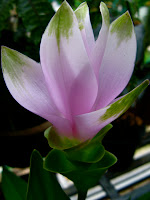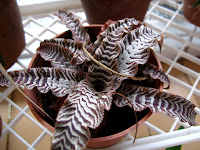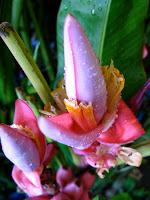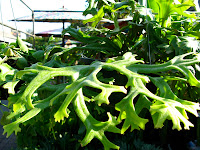 There are quite a few guidebooks on tropical plants out there in the bookstores, but none I feel, can quite compare to this publication: 'Tropical Flowering Plants - A Guide to Identification and Cultivation' by Kirsten Albrecht Llamas. It is probably one of the most comprehensive guides around, containing more than 1500 colour photographs of tropical and sub-tropical flowering plants with descriptions of the families, genera, species and cultivars, including country of origin, general maintenance, propagation and horticultural use. This is truly a bible and a definite must have for any die-hard gardener!
There are quite a few guidebooks on tropical plants out there in the bookstores, but none I feel, can quite compare to this publication: 'Tropical Flowering Plants - A Guide to Identification and Cultivation' by Kirsten Albrecht Llamas. It is probably one of the most comprehensive guides around, containing more than 1500 colour photographs of tropical and sub-tropical flowering plants with descriptions of the families, genera, species and cultivars, including country of origin, general maintenance, propagation and horticultural use. This is truly a bible and a definite must have for any die-hard gardener!
Sunday 29 March 2009
tropical plant guide
 There are quite a few guidebooks on tropical plants out there in the bookstores, but none I feel, can quite compare to this publication: 'Tropical Flowering Plants - A Guide to Identification and Cultivation' by Kirsten Albrecht Llamas. It is probably one of the most comprehensive guides around, containing more than 1500 colour photographs of tropical and sub-tropical flowering plants with descriptions of the families, genera, species and cultivars, including country of origin, general maintenance, propagation and horticultural use. This is truly a bible and a definite must have for any die-hard gardener!
There are quite a few guidebooks on tropical plants out there in the bookstores, but none I feel, can quite compare to this publication: 'Tropical Flowering Plants - A Guide to Identification and Cultivation' by Kirsten Albrecht Llamas. It is probably one of the most comprehensive guides around, containing more than 1500 colour photographs of tropical and sub-tropical flowering plants with descriptions of the families, genera, species and cultivars, including country of origin, general maintenance, propagation and horticultural use. This is truly a bible and a definite must have for any die-hard gardener!
plants that changed the world
 I came across this at Borders yesterday and was immediately taken by its extremely beautiful cover. However, its contents are even more captivating. The author, John Newton fills this book with anecdotes on plants which have changed or influenced mankind. It is also accompanied by beautiful illustrations of botanical art. In John's own words, this book offers a guided tour of the intersection of both flora and fauna in all their complexity and variety, with all the wonders and woes that we have experienced along the way. This definitely deserves a space in my collection of books on plants.
I came across this at Borders yesterday and was immediately taken by its extremely beautiful cover. However, its contents are even more captivating. The author, John Newton fills this book with anecdotes on plants which have changed or influenced mankind. It is also accompanied by beautiful illustrations of botanical art. In John's own words, this book offers a guided tour of the intersection of both flora and fauna in all their complexity and variety, with all the wonders and woes that we have experienced along the way. This definitely deserves a space in my collection of books on plants.
Sunday 22 March 2009
strophanthus





I have got two species of Strophanthus in my garden; one is the Strophanthus gratus (Climbing Oleander) and the other the Strophanthus preussii (Medusa flower). The former produces very pretty pink flowers with a light fragrance. The latter produces small clusters of beautiful blooms with petals which have dangling, twisted sticky maroon threads. Both are reasonably low maintenance and requires some pruning to encourage bushier growth and flowering.
justicia carnea - brazilian plume

This tropical plant is native to northern areas of South America. They come in a range of colours but it is the pink one that holds most gardeners' attention. The bright pink, twin-lipped flowers are produced on large, fat spikes and hang downward in all directions.
The one amazing thing about these spectacular plants are the fact that it does best in shady conditions. One wouldn't have guessed it from looking at the beautiful flowers. I grow mine as a potted plant in my backyard in considerable shade but it does seem to be thriving very well.
It is a very easy plant to grow and regenerates fairly quickly producing new leaves and flowers. However, I would recommend trimming the plant after the flower spikes die off so as to encourage new growth. The plant also requires moist conditions to thrive.
I hear that there is a white flowering form and I cannot wait to get my hands on one.

the beautiful and the weird

If there is one tree I would like to plant in my garden, it has to be the cannonball tree or Couroupita guianensis, and it is not difficult to see why.
While the fruits may be spectacular in their own right, it is the flowers which are truly magnificent! In fact, the cannon ball tree is planted in gardens primarily because of its large, beautiful and pleasantly aromatic flowers. It is quite frankly, unlike any other flower a newcomer to the tropics has ever seen. Even the fruits are a botanical curiosity because they are in the shape and size of cannon balls that, like the flowers, arise from the trunk of the tree. And in contrast to the flowers, they release a foetid aroma when they hit the ground and break open.
Unfortunately, one would require a fairly large garden to grow this tree as the thick woody extensions that grow and cascade from the main brown scaly trunk of the tree does take up quite a bit of space. Still, it is a great specimen for any avid gardener and definitely a talking point of the garden.
Mature specimens can be found at the Singapore Botanic Gardens (Ginger Gardens), the Esplanade and Sembawang parks.


siam tulip



Curcumas are sometimes referred to as the `hidden ginger lily` primarily because of the lush, dense foliage that surrounds the blooms. The blooms come in a wide array of color and sizes and make for excellent cut flowers as they can last as long as two weeks. The most common variety is Curcuma Alismatifolia ‘Siam Tulip’ which is a wonderful pinky mauve that blooms all summer long.
Curcumas bloom spring, summer or fall depending on variety. This beautiful attractive dwarf species is a native of Thailand. It has long narrow pale green/blue stiff leaves and produces a pale purple/pink inflorescence on terminal spike, which can be used as cut flower. Curcumas are herbaceous perennials from Indochina, South East Asia, the Pacific Islands and northern Australia. They have broad, veined leaves, and small, brightly coloured flowers which emerge from large bracts. The flowers range in colour from white to pink, orange and shades of violet. The flower spikes last for several weeks. Curcumas die down in winter and re-emerge in spring, much like bulbs do.
Saturday 21 March 2009
brugmansia

The Brugmansia cutting which Lyndi gave me several months back bloomed today. I have not had much luck with getting it to bloom, partly because it is prone to being ravaged by caterpillars. It is also a heavy feeder and requires very moist fertile soil to thrive. Needless to say, copious amounts of water is required especially during the dry season to prevent the plant from looking limp and drying out.
Brugmansia belongs to a genus of six species of flowering plants in the family Solanaceae. It is native to subtropical regions of South America, along the Andes from Colombia to northern Chile, and also in southeastern Brazil. They are known as Angel's Trumpets, sharing that name with the closely related genus Datura. Brugmansia differs from Datura in being perennial and woody (Datura species are herbaceous), and in having large dramatic pendulous (not erect) flowers. They come in a range of colours such as white, yellow, pink and orange, and have a delicate, attractive scent with light, lemony overtones, most noticeable in early evening.
However, as attractive as the blooms may be, it should be noted that all parts of Brugmansia plants contain dangerous levels of poison and may be fatal if ingested by humans or animals. It is therefore quite strange that caterpillars seem almost immune to these toxic plants.
Brugs can be cultivated fairly easily from stem cuttings. However, do provide them with lots of water and morning sun during the growing stage.
Sunday 15 March 2009
spiny bromeliads and tillandsias
















Over the last couple of months, I have been slowing amassing a collection of Tillandsias (also known as "air plants") and spiny bromeliads consisting mostly of Dyckias and Cryptanthus. Most of the latter were acquired from World Farm, which I understand, had taken over the entire collection from some guy who used to be very into these plants. The Tillandsias on the other hand were acquired mostly from elsewhere, with the latest lot from Chatuchak in Bangkok. The ease of care is probably the main reason why I like these plants. Also, their spiny form is highly dramatic and would look fantastic if incorporated appropriately into the garden-scape.
Saturday 7 March 2009
Chatuchak extravaganza!


























































I have braved the crowds and the heat of Bangkok's infamous Chatuchak weekend market countless times but as its namesake suggests, I usually only go there on weekends. So when Illy told me that the place becomes an exclusive plant market on Wednesdays and Thursdays, I promptly booked myself a flight up to Bangkok last Tuesday evening. The days leading up to the trip was met with much excitement and anticipation. Much of it was fuelled by the very encouraging advice given by the usual (gardening) suspects on the plant forum I belong to. In fact, they seemed a whole lot more excited than I was, telling me what to look out for, where the best deals were, how much I ought to bargain for certain plants, how early I ought to get there etc. It was all very amusing.
So, I wasted no time at all and left for the market after an early breakfast with Illy at the hotel. If there is such a thing as plant heaven, then Chatuchak is as close to heaven as one can get. The perimeter roads were lined with stall after stall selling just plants; orchids, bromeliads, nepenthes, flowering shrubs, creepers and vines etc. The entire market was just brimming with endless possibilities.
I spent the first hour walking around the entire perimeter, taking photographs and scouting for rare finds and good buys. Although the thought of having to clear customs in both Bangkok and Singapore and risk having the plants confiscated did weigh heavily on my mind. But I caved in to my apprehension and ended up with quite a significant haul consisting of 3 clumps of spanish moss, a bagful of tillandsias, 3 bromeliads (A. triangularis, A. tillandsoids & N. pauciflora) , 3 pots of nepenthes, one passiflora, eight species of orchids, a bag of live sphagnum moss and three variegated Xanthosoma (a sort of aroid). There were others which I regret not getting, but there's only so much that I can carry home by myself. The next time around, I will bring Gerry with me.
I have to say though, the nepenthes and in particular, the A. triangularis did appear rather dubious over the x-ray machines.
Subscribe to:
Posts (Atom)

